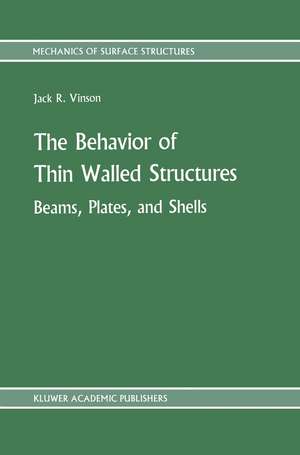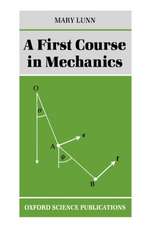The Behavior of Thin Walled Structures: Beams, Plates, and Shells: Mechanics of Surface Structure, cartea 8
Autor Jack R. Vinsonen Limba Engleză Hardback – 31 dec 1988
| Toate formatele și edițiile | Preț | Express |
|---|---|---|
| Paperback (1) | 635.65 lei 6-8 săpt. | |
| SPRINGER NETHERLANDS – 30 sep 2011 | 635.65 lei 6-8 săpt. | |
| Hardback (1) | 641.85 lei 6-8 săpt. | |
| SPRINGER NETHERLANDS – 31 dec 1988 | 641.85 lei 6-8 săpt. |
Preț: 641.85 lei
Preț vechi: 755.13 lei
-15% Nou
Puncte Express: 963
Preț estimativ în valută:
122.83€ • 133.38$ • 103.18£
122.83€ • 133.38$ • 103.18£
Carte tipărită la comandă
Livrare economică 23 aprilie-07 mai
Preluare comenzi: 021 569.72.76
Specificații
ISBN-13: 9789024736638
ISBN-10: 9024736633
Pagini: 198
Ilustrații: XII, 182 p.
Dimensiuni: 155 x 235 x 16 mm
Greutate: 0.46 kg
Ediția:1989
Editura: SPRINGER NETHERLANDS
Colecția Springer
Seria Mechanics of Surface Structure
Locul publicării:Dordrecht, Netherlands
ISBN-10: 9024736633
Pagini: 198
Ilustrații: XII, 182 p.
Dimensiuni: 155 x 235 x 16 mm
Greutate: 0.46 kg
Ediția:1989
Editura: SPRINGER NETHERLANDS
Colecția Springer
Seria Mechanics of Surface Structure
Locul publicării:Dordrecht, Netherlands
Public țintă
ResearchCuprins
1. Equations of Linear Elasticity in Cartesian Coordinates.- 1.1 Stresses.- 1.2 Displacements.- 1.3 Strains.- 1.4 Isotropy and Its Elastic Constants.- 1.5 Equilibrium Equations.- 1.6 Stress-Strain Relations.- 1.7 Linear Strain-Displacement Relations.- 1.8 Compatibility Equations.- 1.9 Summary.- 1.10 References.- 1.11 Problems.- 2. Derivation of the Governing Equations for Beams and Rectangular Plates.- 2.1 Assumptions of Plate Theory.- 2.2 Derivation of the Equilibrium Equations for a Plate.- 2.3 Derivation of Plate Moment-Curvature Relations and Integrated Stress Resultant- Displacement Relations.- 2.4 Derivation of the Governing Equations for a Plate.- 2.5 Boundary Conditions.- 2.6 Stress Distribution within a Plate.- 2.7 References.- 2.8 Problems.- 3. Beams and Rods.- 3.1 General Remarks.- 3.2 Development of the Governing Equations.- 3.3 Solutions for the Beam Equation.- 3.4 Stresses in Beams — Rods — Columns.- 3.5 Example: Clamped-Clamped Beam with a Constant Lateral Load, q(x) = -q0.- 3.6 Example: Cantilevered Beam with a Uniform Lateral Load, q(x) = -q0.- 3.7 Example: Simply Supported Beam with a Uniform Load over Part of Its Length.- 3.8 Beam with an Abrupt Change in Stiffness.- 3.9 Beam Subjected to Concentrated Loads.- 3.10 Solutions by Green’s Functions.- 3.11 Tapered Beam Solution Using Galerkin’s Method.- 3.12 Problems.- 4. Solutions to Problems of Rectangular Plates.- 4.1 Some General Solutions to the Biharmonic Equation.- 4.2 Double Series Solution (Navier Solution).- 4.3 Single Series Solution (Method of M. Levy).- 4.4 Example of Plate with Edges Supported by Beams.- 4.5 Summary.- 4.6 References.- 4.7 Problems.- 5. Thermal Stresses in Plates.- 5.1 General Considerations.- 5.2 Derivation of the Governing Equations for a Thermoelastic Plate.- 5.3Boundary Conditions.- 5.4 General Treatment of Plate Nonhomogeneous Boundary Conditions.- 5.5 Thermoelastic Effects on Beams.- 5.6 Self-Equilibration of Thermal Stresses.- 5.7 References.- 5.8 Problems.- 6. Circular Plates.- 6.1 Introduction.- 6.2 Derivation of the Governing Equations.- 6.3 Axially Symmetric Circular Plates.- 6.4 Solutions for Axially Symmetric Circular Plates.- 6.5 Circular Plate, Simply Supported at the Outer Edge, Subjected to a Uniform Lateral Loading, p0.- 6.6 Circular Plate, Clamped at the Outer Edge, Subjected to a Uniform Lateral Loading, p0.- 6.7 Annular Plate, Simply Supported at the Outer Edge, Subjected to a Stress Couple, M, at the Inner Boundary.- 6.8 Annular Plate, Simply Supported at the Outer Edge, Subjected to a Shear Resultant, Q0, at the Inner Boundary.- 6.9 General Remarks.- 6.10 Problems.- 7. Buckling of Columns and Plates.- 7.1 Derivation of the Plate Governing Equations for Buckling.- 7.2 Buckling of Columns Simply Supported at Each End.- 7.3 Column Buckling with Other Boundary Conditions.- 7.4 Buckling of Plates Simply Supported on All Four Edges.- 7.5 Buckling of Plates with Other Loads and Boundary Conditions.- 7.6 References.- 7.7 Problems.- 8. The Vibrations of Beams and Plates.- 8.1 Introduction.- 8.2 Natural Vibrations of Beams.- 8.3 Natural Vibrations of Plates.- 8.4 Forced Vibrations of Beams and Plates.- 8.5 References.- 8.6 Problems.- 9. Energy Methods in Beams, Columns and Plates.- 9.1 Introduction.- 9.2 Theorem of Minimum Potential Energy.- 9.3 Analysis of Beams Subjected to a Lateral Load.- 9.4 The Buckling of Columns.- 9.5 Vibration of Beams.- 9.6 Minimum Potential Energy for Rectangular Plates.- 9.7 The Buckling of a Plate under Uniaxial Load, Simply Supported on Three Sides, and Free on an Unloaded Edge.- 9.8 Functions to Assume in the Use of Minimum Potential Energy for Solving Beam, Column, and Plate Problems.- 9.9 Problems.- 10. Cylindrical Shells.- 10.1 Cylindrical Shells under General Loads.- 10.2 Circular Cylindrical Shells under Axially Symmetric Loads.- 10.3 Edge Load Solutions.- 10.4 A General Solution for Cylindrical Shells under Axially Symmetric Loads.- 10.5 Sample Solutions.- 10.6 Circular Cylindrical Shells under Asymmetric Loads.- 10.7 Shallow Shell Theory (Donnell’s Equations).- 10.8 Inextensional Shell Theory.- 10.9 Membrane Shell Theory.- 10.10 Examples of Membrane Theory.- 10.11 References.- 10.12 Problems.- 11. Elastic Stability of Shells.- 11.1 Buckling of Isotropic Circular Cylindrical Shells under Axially Symmetric Axial Loads.- 11.2 Buckling of Isotropic Circular Cylindrical Shells under Axially Symmetric Axial Loads and an Internal Pressure.- 11.3 Buckling of Isotropic Circular Cylindrical Shells under Bending.- 11.4 Buckling of Isotropic Circular Cylindrical Shells under Lateral Pressures.- 11.5 Buckling of Isotropic Circular Cylindrical Shells in Torsion.- 11.6 Buckling of Isotropic Circular Cylindrical Shells under Combined Axial Loads and Bending Loads.- 11.7 Buckling of Isotropic Circular Cylindrical Shells under Combined Axial Load and Torsion.- 11.8 Buckling of Isotropic Circular Cylindrical Shells under Combined Bending and Torsion.- 11.9 Buckling of Isotropic Circular Cylindrical Shells under Combined Bending and Transverse Shear.- 11.10 Buckling of Isotropic Circular Cylindrical Shells under Combined Axial Compression, Bending and Torsion.- 11.11 Buckling of Isotropic Spherical Shells under External Pressure.- 11.12 Buckling of Anisotropic and Sandwich Cylindrical Shells.- 11.13 References.- 11.14 Problems.- 12. The Vibration of CylindricalShells.- 12.1 Governing Differential Equations for Natural Vibrations.- 12.2 Hamilton’s Principle for Determining the Natural Vibrations of Cylindrical Shells.- 12.3 Reference.- Appendix 1. Properties of Useful Engineering Materials.- Appendix 2. Answers to Selected Problems.
Recenzii
`This book is highly recommended as a text for a first course on plates and shells with emphasis on engineering applications. It can also be used for self-study and will provide a solid background for further learning.'
Journal of Applied Mechanics, 57 (1990)
Journal of Applied Mechanics, 57 (1990)
Notă biografică
Dr. Vinson is the H. Fletcher Brown Professor of Mechanical and Aerospace Engineering at the University of Delaware. In 1977 he received the ONR-AIAA Structural Mechanics Award for his research in composite materials, and in 1981 he was awarded an ASME Centennial Award. He is active as a consultant to government and industry. He recently received a Fellowship from the Japan Society for the Promotion of Science for 1985. He has been Chairman of the American Organizing Committee for the Japan-United States Conferences on Composite Materials three times (1981, 1983 and 1986).



















